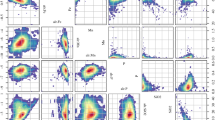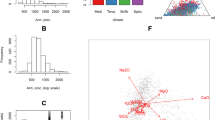Abstract
The additive logratio (alr) transformation has been used in several case studies to predict regionalized compositions using standard geostatistical estimation methods such as ordinary kriging and ordinary cokriging. It is a simple method that allows application to transformed data all the body of knowledge available for geostatistical analysis of coregionalizations without a constant sum constraint. To compare the performance of methods, it is customary to use a univariate crossvalidation approach based on the leaving-one-out technique to evaluate the performance for each attribute separately. For multivariate observations this approach is difficult to interpret in terms of overall performance. Therefore, we propose using appropriate distances in real space and in the simplex, to improve the crossvalidation approach and, going a step forward, to adapt the concept of stress from multidimensional scaling to obtain a global measure of performance for each method. The Lyons West oil field of Kansas is used to illustrate the impactof using different distances in the performance of ordinary kriging versus ordinary cokriging.
Similar content being viewed by others
REFERENCES
Aitchison, J., 1986, The statistical analysis of compositional data, Monographs on statistics and applied probability: Chapman & Hall, London, 416 p.
Aitchison, J., 1997, The one-hour course in compositional data analysis or compositional data analysis is simple, in Pawlowsky-Glahn, V., ed., Proceedings of IAMG'97--The third annual conference of the International Association for Mathematical Geology,Vols. I, II and addendum: International Center for Numerical Methods in Engineering (CIMNE), Barcelona (E), p. 3–35.
Barnes, R. J., 1991, The variogram sill and the sample variance: Math. Geol., v. 23, no. 4, p. 673–678.
Buccianti, A., Pawlowsky-Glahn, V., Barceló-Vidal, C., and Jarauta-Bragulat, E., 1999, Visualization and modeling of natural trends in ternary diagrams: A geochemical case study, in Lippard, S. J., Næss, A., and Sinding-Larsen, R., eds., Proceedings of IAMG'99--The fifth annual conference of the International Association for Mathematical Geology, Vols. I and II: Tapir, Trondheim, p. 139–144.
Buckles, R. S., 1965, Correlating and averaging connate water saturation data: J. Can. Pet. Technol., v. 4, no. 1, p. 42–52.
Davis, B. M., 1987, Uses and abuses of cross-validation in geostatistics: Math. Geol., v. 19, no. 3, p. 241–248.
De Gruijter, J. J., Walvoort, D. J. J., and van Gaans, P. F. M., 1997, Continuous soil maps--A fuzzy set approach to bridge the gap between aggregation levels of process and distribution models: Geoderma, v. 77, p. 169–195.
Diggle, P. J., Tawn, J. A., and Moyeed, R. A., 1998, Model-based geostatistics (with discussion): J. R. Stat. Soc., Ser. C (Appl. Stat.), v. 47, no. 3, p. 299–350.
Ehm, A. E., 1965, Lyons West field: Kansas oil and gas fields, Technical report: Kansas Geological Society, p. 146–156.
Jobson, J. D., 1992, Applied multivariate data analysis, Vol. II: Categorical and multivariate analysis: Springer-Verlag, New York, 731 p.
Krzanowski, W. J., 1988, Principles of multivariate analysis: A user's perspective, Vol. 3 of Oxford statistical science series: Clarendon Press, Oxford, 563 p.
Ma, X., and Yao, T., 2001, A program for 2D modeling (cross)correlogram tables using Fast Fourier Transform: Computers & Geosciences, v. 27, no. 7, p. 763–774.
Martín-Fernández, J. A., Barceló-Vidal, C., and Pawlowsky-Glahn, V., 1998, Measures of difference for compositional data and hierarchical clustering methods, in Buccianti, A., Nardi, G., and Potenza, R., eds., Proceedings of IAMG'98--The fourth annual conference of the International Association for Mathematical Geology, Vols. I and II: De Frede Editore, Napoli, p. 526–531.
Martín-Fernández, J. A., Bren, M., Barceló-Vidal, C., and Pawlowsky-Glahn, V., 1999, A measure of difference for compositional data based on measures of divergence, in Lippard, S. J., Næss, A., and Sinding-Larsen, R., eds., Proceedings of IAMG'99--The fifth annual conference of the International Association for Mathematical Geology, Vols. I and II: Tapir, Trondheim, p. 211–216.
Olea, R. A., 1999, Geostatistics for engineers and earth scientists: Kluwer Academic Publishers, Norwell, MA, 303 p.
Pawlowsky, V., 1989, Cokriging of regionalized compositions: Math. Geol., v. 21, no. 5, p. 513–521.
Pawlowsky, V., and Burger, H., 1992, Spatial structure analysis of regionalized compositions: Math. Geol., v. 24, no. 6, p. 675–691.
Pawlowsky, V., Olea, R., and Davis, J. C., 1995, Estimation of regionalized compositions: Acomparison of three methods: Math. Geol., v. 27, no. 1, p. 105–127.
Yao, T., and Journel, A. G., 1998, Automatic modeling of (cross) covariance tables using Fast Fourier Transform: Math. Geol., v. 30, no. 6, p. 589–615.
Author information
Authors and Affiliations
Rights and permissions
About this article
Cite this article
Martín-Fernández, J.A., Olea-Meneses, R.A. & Pawlowsky-Glahn, V. Criteria to Compare Estimation Methods of Regionalized Compositions. Mathematical Geology 33, 889–909 (2001). https://doi.org/10.1023/A:1012293922142
Issue Date:
DOI: https://doi.org/10.1023/A:1012293922142




